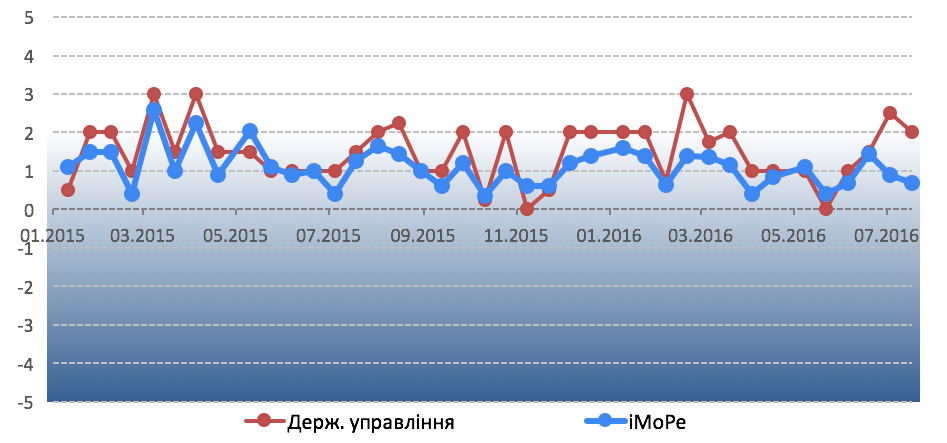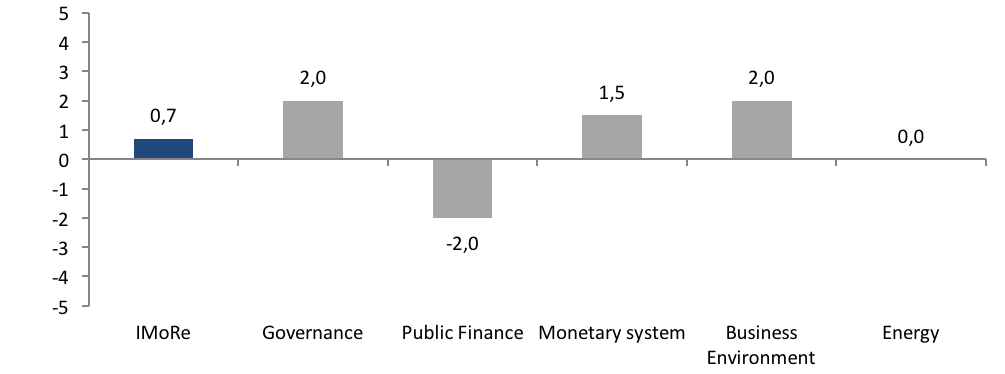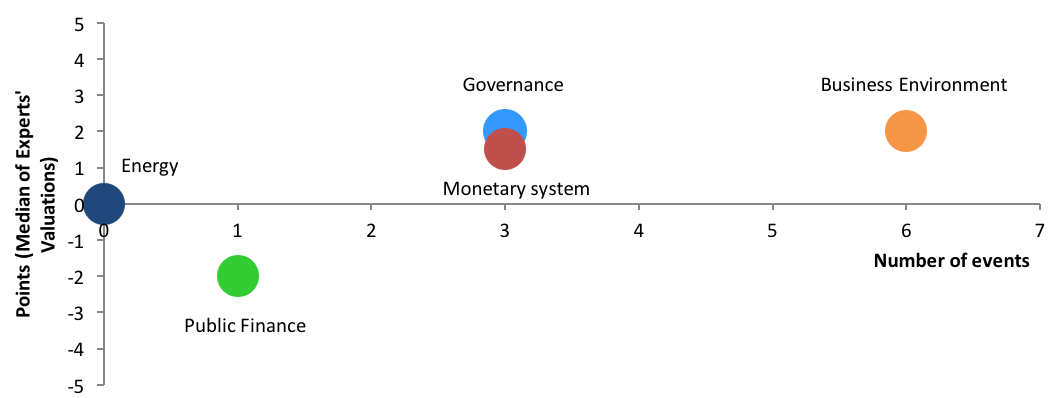Judicial reforms keep Reform Index in a positive territory. Nevertheless, the value of the index remains low, this time due to the unconsidered government decision to increase the number of publicly financed spots for students at universities and the lack of significant developments in public finances and energy.
Chart 1. Reform Index dynamics*
* Reform Index team considers index value of at least 2 an acceptable pace of reform
Chart 2. Reform Index and its components in the current round**
**Titles of components were shortened for convenience, while their content remained the same
The most important reforms of the first half of July were the law on the judicial system and the status of judges, as well as the reform of the court decisions’ enforcement system, in addition to the efforts of the NBU to ensure the stability of the banking sector. Despite these advances, the Index for Monitoring Reforms fell to +0.7 points in the first half of July, from +0.9 in the second half of June. The reason for this was the unconsidered government decision to increase the number of publicly financed spots at universities and the lack of substantial progress in the public finance and energy sectors.
The Most Important Positive Developments
1) Continuing with Judicial Reform
The law on the judicial system and the status of judges: +5.5 points
The law 1402-VIII of 02.06.2016 — the so-called “field-specific” or “implementing” law — is part of the judicial reform and the first legislative act to implement the principles defined by the amendments to the Constitution of Ukraine on the justice system. It simplifies the structure of the judicial system, introduces new principles of judicial selection, and increases the responsibility of judges and mechanisms for guaranteeing verification to civil society. The law will help to revitalize, depoliticize and strengthen the independence of judicial authorities.
The current four-level justice system is replaced by a three-level one: local courts, courts of appeal, the new Supreme Court. High specialized courts (The High Administrative Court, High Commercial Court and High Specialized Court on Civil and Criminal Cases) are eliminated, and instead appeal divisions will be established in the structure of the Supreme Court. There will be two new courts: The High Anti-Corruption Court and the High Intellectual Property Court, which will be the courts of the original jurisdiction for the corresponding categories of cases. The Supreme Court should be established according to new rules within six months from the date the law is enacted, the High Intellectual Property Court within one year, and the High Anti-Corruption Court within one year from the adoption of the relevant legislation.
Judicial system renewal will start from the Supreme Court — the highest court in the judicial system that will be created “from scratch”. Not only judges with experience, as it is now, but also attorneys and academic lawyers with ten years’ legal experience will be able to join the Supreme Court. The selection of Supreme Court judges will be conducted by the High Qualification Commission of Judges.
To assure the de-politicization of justice the court is formed, reorganized and liquidated by laws. Starting from 2018 the President will lose the authority to create and liquidate the court by decree. The Parliament’s authority to give consent to arrest judges was transferred to the High Council of Justice. The initial five-year probationary period for judges was eliminated; now judges are appointed permanently.
The law raises the professional standards for judges and introduces new principles of judicial selection. In particular, it introduces a competitive selection of judges. According to the law, representatives of academia and bar, including Ukrainians who were educated or worked abroad, can now participate in the contest as well. The High Qualification Commission of Judges will conduct the competitive selection and qualification of judges based on the criteria of competence, professional ethics and integrity. The law foresees the creation of the Public Integrity Council which will contribute to the High Qualification Commission of Judges in evaluating the compliance of judges with the criteria of professional ethics and integrity. The High Council of Justice proposes candidates for a judicial post to the President. The law also introduces monitoring of judges’ lifestyle. In addition to the income statement, all judges must submit integrity and family relation declarations. The remuneration of judges is raised significantly; this will be implemented gradually.
In general, experts assessed the law very positively, once again stressing that judicial reform is a key element to ensure property rights protection, and therefore the development of a market economy. Nevertheless, experts have noted several risks. For example, in their opinion, mechanisms to ensure the independence of judges and renew the judiciary are insufficient, with the disadvantages including the possibility to extend term of court’s chief judge (a position that normally rotates among the judges), as well as the issuance of judgeships by the President and the fact that judges swear into office before him.
This law is the first of the implementing regulations, which focuses on three main objectives of judicial reform — de-politicization and ensuring the independence of the judiciary, increasing the responsibility of judges and revitalization of the judiciary. It also settled the question of public control in establishing judges’ compliance with the criteria of professional ethics and integrity, and participation of representatives of civil society organizations in monitoring the lifestyle of the judges and candidates for judges. These solutions, along with the opportunity for candidates from outside the judicial system to participate in the competitive selection process, will permit the system to be ‘restarted’, while keeping balance between international standards of justice and the requirements of the Ukrainian society.
— Oleksiy Filatov, Coordinator of the Judicial Reform Council
The adopted law creates a new opportunity for judicial reform and the purification of the judiciary after two failed attempts. At the same time, the law contains important shortcomings, in particular it does not regulate the procedure for the establishment of The High Anti-Corruption Court (the creation of which then requires the development and adoption of a separate law) and allows a compromised chief judge to keep his or her position.
— Dmitry Kotlyar, Reanimation Package of Reforms Initiative
Enforcement system of court decisions reform: +4 points
Non-enforcement of court decisions is one of the key problems of Ukraine’s justice system. The parties wishing to enforce court decisions have to wait for years. To get the guaranteed by government service from an enforcement officer, the parties often engage in corruption. According the Minister of Justice Pavlo Petrenko, only 20% of court decisions are enforced in Ukraine. Hence, the institute of state enforcement officers does not work and generates high corruption risks.
Novel legislation (laws 1403-VIII and 1404-VIII from 02.06.2016) disassemble the state monopoly on the court decisions enforcement. They introduce the institute of private enforcement officers. Private and state enforcement officers, regarding a certain category of court decisions, will have the same authority and mechanisms at their disposal, so that people will have the possibility to choose whether to use the private or state officers. The state enforcement officers will retain their monopoly over certain categories of cases, such as child custody disputes, eviction cases or enforcement of decisions against the state or municipal authorities. The introduction of a similar model in Poland played an important role in increasing the fraction of court decisions that are enforced up to 80%.
The experts evaluated these laws positively and pointed out that the enforcement of court decisions is among the key problems of the Ukrainian justice system.
The adoption of two new specialized laws gives a start to large-scale reform of enforcement of court decisions. The key innovation is the introduction of private enforcement officers who will be empowered to enforce a wide range of decisions of courts and other bodies alongside the state executive service. First of all, the introduction of competition and market mechanisms in this monopolized sphere creates expectations for a significant increase in performance indicators, evident reduction of procedures terms and increased satisfaction of numerous participants of proceedings. Given that the enforcement is in fact the final stage of litigation, the reform of this sector will help to restore public confidence in the judiciary and court processes as a whole.
— Sergiy Shklyar, Deputy Minister of Justice of Ukraine for Enforcement Service
It is expected that the private enforcement officers will have higher motivation for court decisions enforcement. Hopefully, it will influence positively on collaterals’ collection from problem bank borrowers, which is a step toward the improvement of the creditors’ rights protection.
— Dmytro Yablonovskyy, GfK Ukraine
It is difficult to predict the results, as it depends on implementation. Potentially, a problem may lie in the combination on private enforcement officers, absence of a legal background and unfair court decisions.
— Denys Bigus, journalist investigation project “Nashi Hroshi”
2) The Regulation for Measuring Credit Risk Assessment by banks: +2 points
The corresponding NBU Board resolution 351 of 30.06.2016 should ensure proper and timely assessment of credit risk by banks, prevent lending to insolvent borrowers and therefore have a positive impact on the banking system’s stability.
The new procedures, developed in conjunction with experts from international financial institutions, are based on the Basel principles of banking supervision. They require standardized approaches, including an econometric model for the calculation of legal entities’ risks and qualitative and quantitative indicators for other debtors, an assessment of the borrower’s credit risk based on the characteristics of the group of companies interlinked with the borrower, enhanced requirements for credit collateral, etc.
The regulation will take effect in a “test mode” from 1 September 2016 and will be compulsory from 3 January 2017. Therefore, banks will have time to prepare for the new requirements.
The adoption of the new regulation for Measuring Credit Risk Generated by Banks’ Asset Operations will provide the National Bank tools for continuous monitoring of the quality of banks’ assets and, as a consequence, the adequacy of their capital. We also expect that the introduction of the regulation will limit risky approaches to lending, which happened in the past, and will facilitate access to credit for financially stable, successful companies.
— Igor Budnyk, the National Bank of Ukraine, the Department of Risk Management
A prudent and standardized approach of banks to credit risk assessment would reduce the growth rate of “bad” loans and bank failures during economic crises. In the short term, a more rigorous approach to credit risk assessment may limit the pace of bank lending recovery, but due to low quality loans, including related-party loans. This is a case where less is better.
— Olena Bilan, chief economist at Dragon Capital, member of VoxUkraine editorial board
Antireform
3) The government increased the number of publicly financed spots at universities: -2 points
The government decided to increase the number of publicly financed spots for students at universities by 12.3% (the CMU decree 408 of 06.07.2016). The government’s plan for 2016 announced the Cabinet’s intention to bring the state sponsorship of university students to meet the real needs of the labor market.
The quality of higher education in Ukraine is low and the graduates are not well prepared to enter the labor market. The strategy to reform higher education, which is still in development in the Ministry of Education and Science, should address possible solutions to these issues. Meanwhile there were no significant steps toward improving the quality of higher education.
Explanations about financing of this government decision are controversial. In particular, Vice Prime Minister of Ukraine Pavlo Rozenko noted that the number of publicly financed spots at universities corresponds to the amount of financing already allocated for this purpose and no additional resources are required. At the same time, the Minister of Finance pointed out that the development will require additional allocation of at least UAH 800 million from the budget next year.
Currently the education sector is experiencing a turbulent stage of reforms related to the abolition of the degrees of junior specialist and specialist, the transfer of vocational schools to the local level, an increase in publicly financed spots in defense-sector education due to the anti-terrorist operation. Partly an increase in the number of government-financed student positions is explained by these factors. But in the long run increase of publicly financed spots does not meet demographic situation, the needs of the labor market and the available financial resources in the budget to support the huge number of students. According to the Ministry of Education and Science, this year 80% of high school graduates will go to universities. For resource-based economy like Ukraine, such a high level implies distortions in the labor market (shortage of skilled workers, while a huge number of economists, managers, lawyers).
— Maria Repko, Centre for Economic Strategy
Chart 3. Value of Reform Index components and number of events July 4 – 17, 2016
Reform Index aims to provide a comprehensive assessment of reform efforts by Ukraine’s authorities. The Index is based on expert assessments of changes in the regulatory environment in five areas:
- Governance
- Public Finance
- Monetary system
- Business Environment
- Energy
For details please visit reforms.voxukraine.org
Attention
The author doesn`t work for, consult to, own shares in or receive funding from any company or organization that would benefit from this article, and have no relevant affiliations






